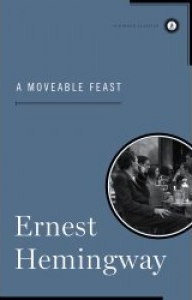By Alexei C. Summers (Contributor) – Email
Date Posted: September 27, 2011
Print Edition: September 21, 2011
 “If you are lucky enough to have lived in Paris as a young man, then wherever you go for the rest of your life, it stays with you, for Paris is a moveable feast” -Ernest Hemingway
“If you are lucky enough to have lived in Paris as a young man, then wherever you go for the rest of your life, it stays with you, for Paris is a moveable feast” -Ernest Hemingway
A Moveable Feast affirms grace under pressure. Ernest Hemingway’s legendary terse, short and simple writing style has throughout the ages captured the attention of readers all over the globe, and for any fan of the Modernist Literary Era it is a must-read.
The idea for the literary non-fiction story was conceived when Hemingway received word from the Paris Ritz Hotel that he had two trunks left in the basement from long ago in his days when he lived there. Hemingway had forgotten all about these trunks, and went to inspect them. What he found was his old clothes from his years as a young American Expatriate, and old writings documenting the time he lived in Paris. This sparked the idea in his mind that he would write about Paris in the 1920s, from his own perspective, using these lost writings as the basis.
Regarded by many as the most important author for American English Literature of the twentieth century, Ernest Hemingway never got to finish A Moveable Feast. He left it ultimately unfinished, committing suicide with his double-barrel shotgun on the morning of July 2, 1962, before being able to complete it.
His family pieced together the unfinished non-fiction memoir for publication, and in 1964, two years after his suicide, Ernest’s wondrous tale of Paris in the 1920s – his most treasured time – came to life on the printed page. The reader was, and still is, thrust immediately into a first-person view of what it was like to live as an artist writer in the 1920s café society that Ernest Hemingway was a part of.
The reader gets to know all the most important people of the time period, and with the way Hemingway writes this beautiful memoir, it feels like one is really meeting them. Colourful figures such as F. Scott Fitzgerald, and his wife Zelda, James Joyce, and Gertrude Stein, all come to life. Though the characters are vivid, one also gets the feeling that Hemingway has, at times, taken liberties and some things may have been exaggerated for the reader’s enjoyment. The voice in which the story is written has a natural flow to it, and one can almost hear an aged Ernest Hemingway speaking the words aloud with each sentence.
The story examines the attitudes of the decade, in which many Americans sought comfort in a society far away from their Puritan homeland, thus migrating back to the Europe of their forefathers, and taking refuge particularly in Paris. Shocked by the Great War that was intended to be the “war to end all wars,” a new generation was born: a disillusioned one that watched as the old world crumbled around them. Writers and artists prospered in Paris, and Hemingway shows us this through his immaculately kept records that were recorded in the actual daily life that he led in his days in France.
Hemingway’s portrayal of the Roaring Twenties is a bit different from the portrayals of his fellow writer, and friend, F. Scott Fitzgerald, who portrays it as all one big rip-roaring party, even coining the term “Jazz Age” to describe it. Hemingway’s Jazz Age was evidently much more sombre than Scott’s.
The tale of A Moveable Feast is a romantic one. One that has been read throughout the years with a nostalgia of a generation that the reader may not have even lived in. Originally published by the legendary publishing company Scribner, famous for their decorative book covers, A Moveable Feast’s most common edition is from 2003, which includes photographs of the café society circles Hemingway interacted with, as well as pictures of his first wife Hadley, who is also included in the book.
In A Moveable Feast, Hemingway writes to not only those of his generation, but also to those lost generations that have yet to come – that have yet to become lost. That is perhaps why this book has been so timelessly enjoyed by so many. As Hemingway reflects on his youth in A Moveable Feast, he does not specifically say it, as Hemingway often would do, but the reader can gather that he is trying to remind his readers to treasure youth, beauty and love, for these things are transient and they slip away in time. In all his works, it is one of his most reoccurring themes. Hemingway is once again trying to tell us, one last time before he takes his final curtain call, that the sun also rises.


